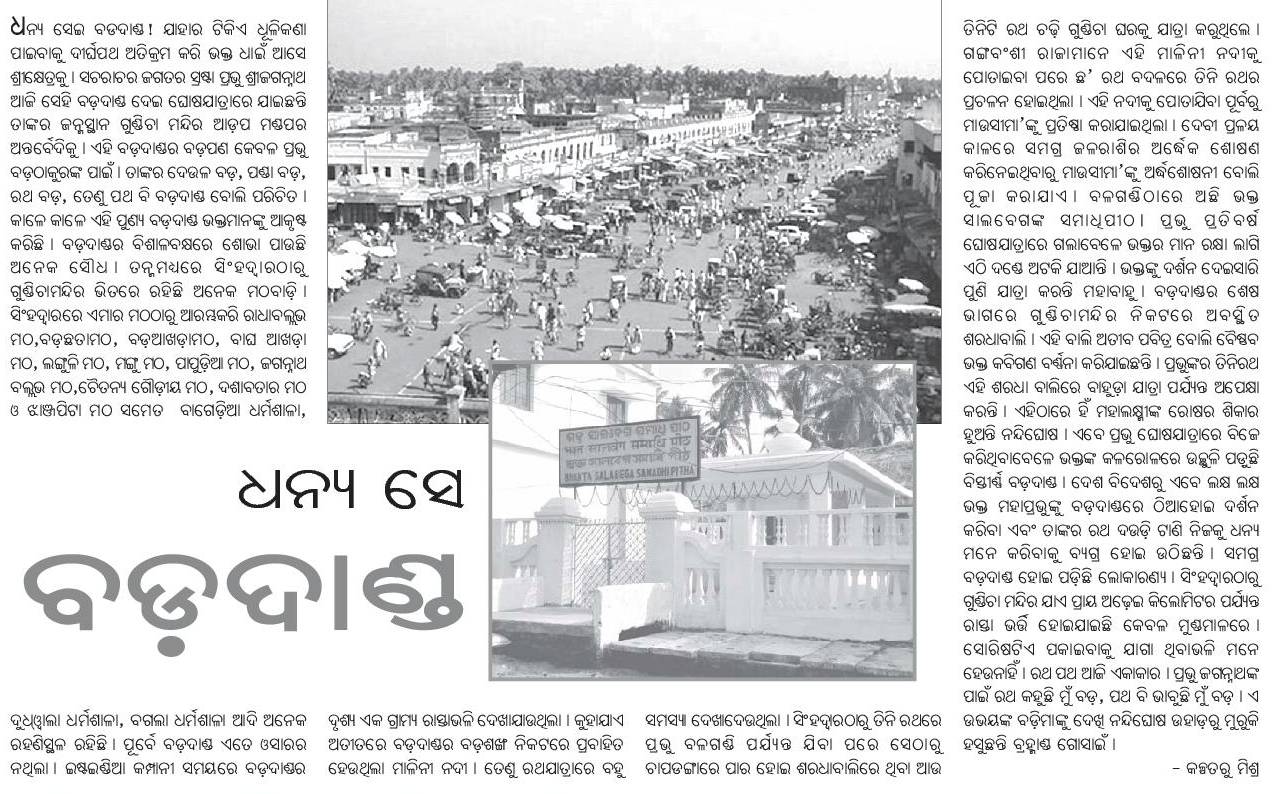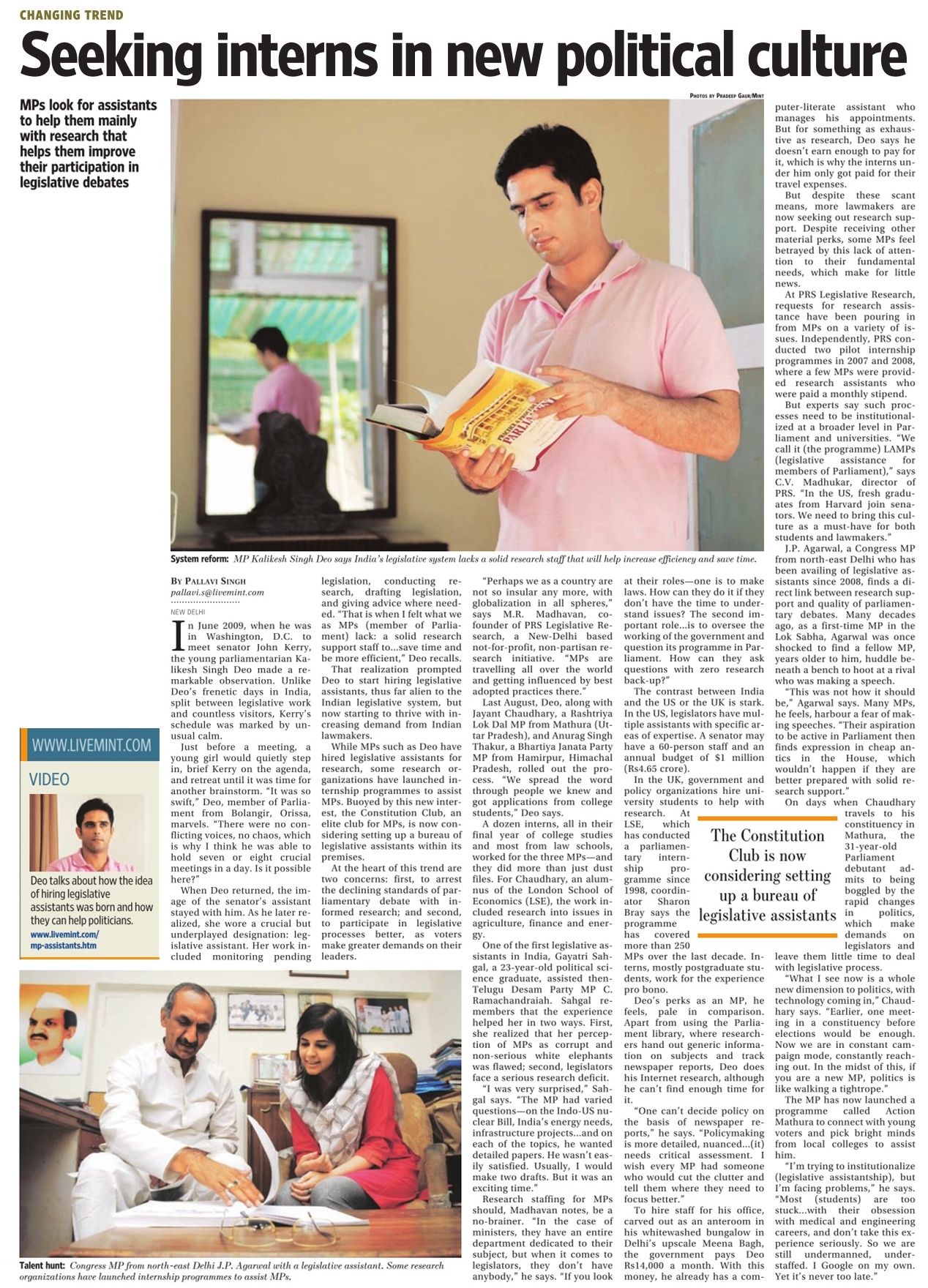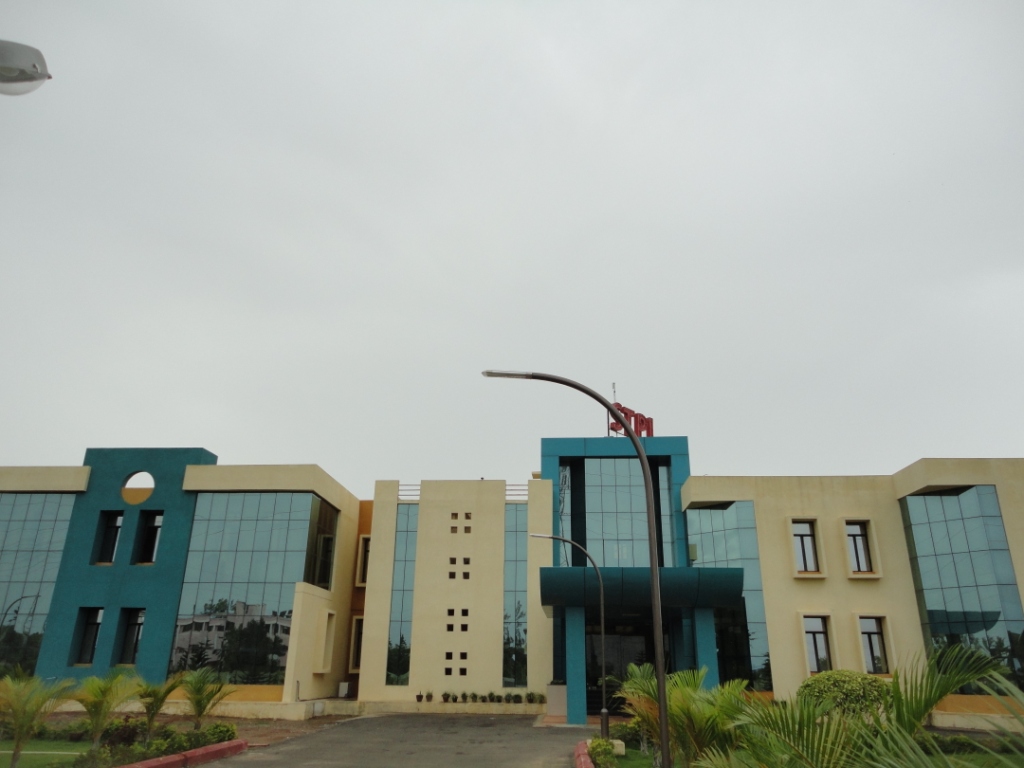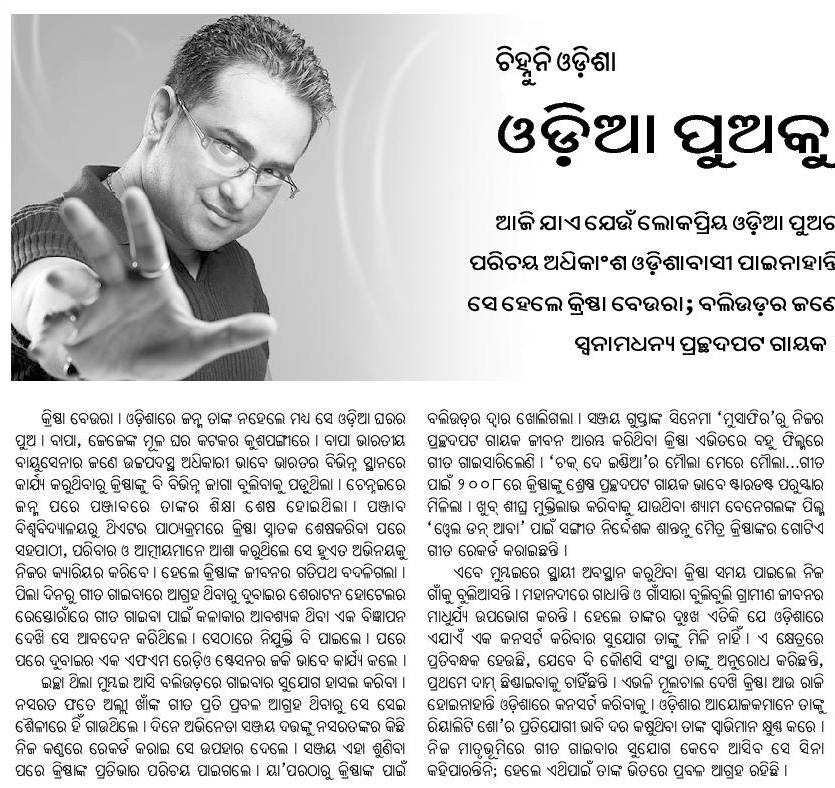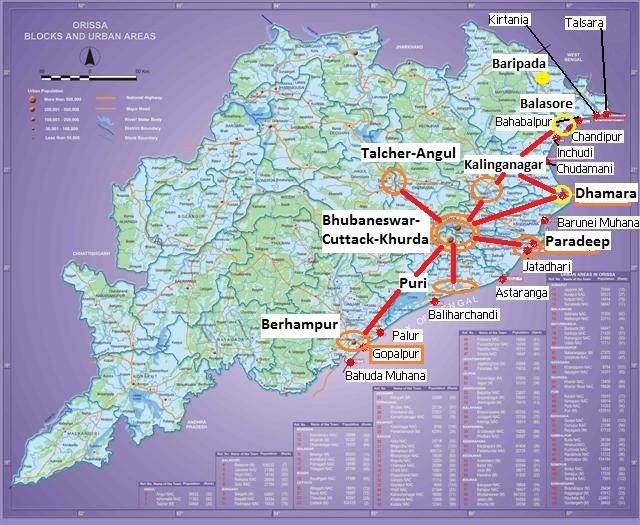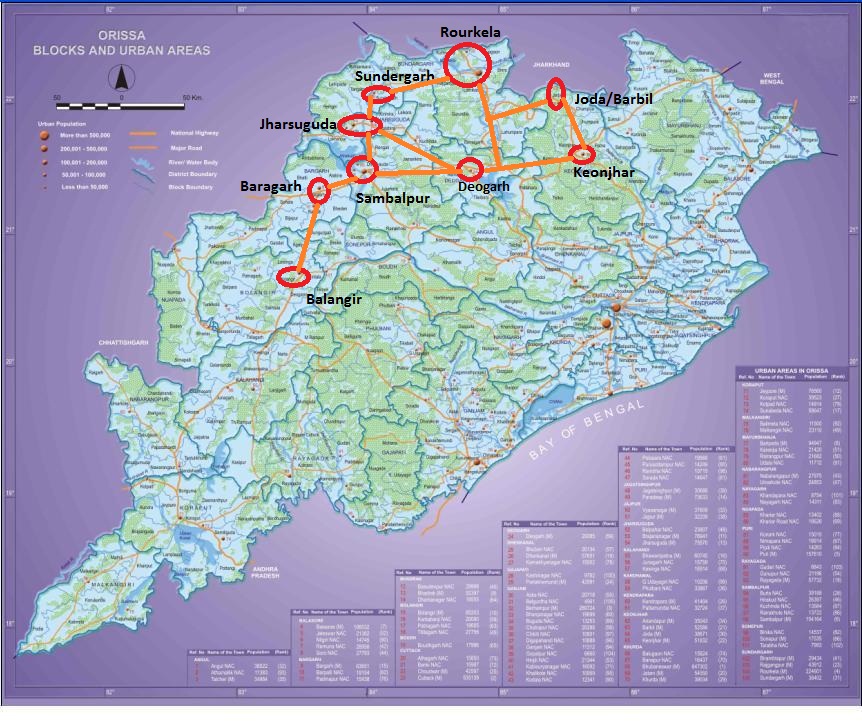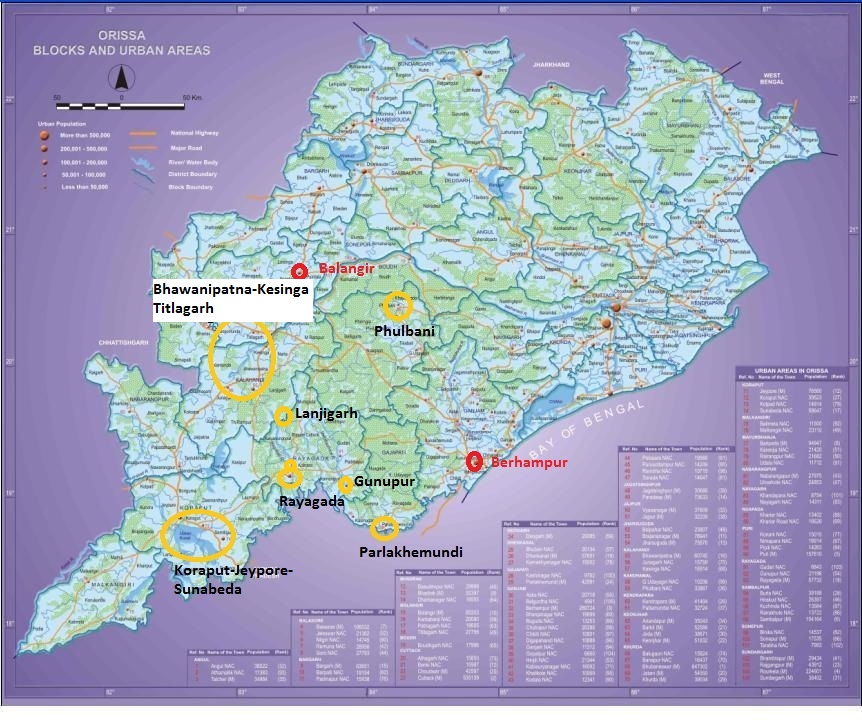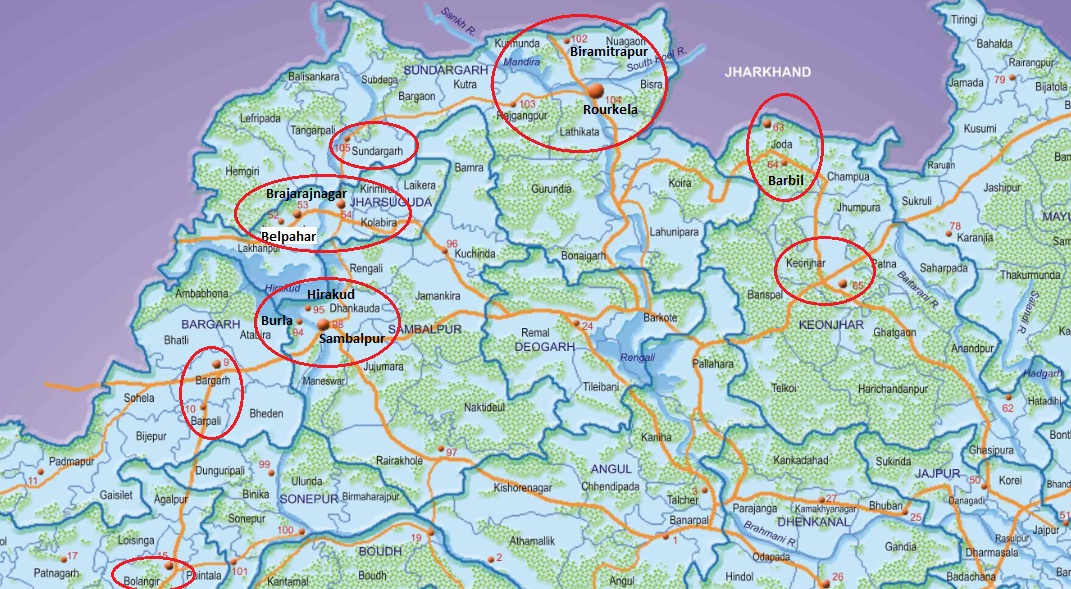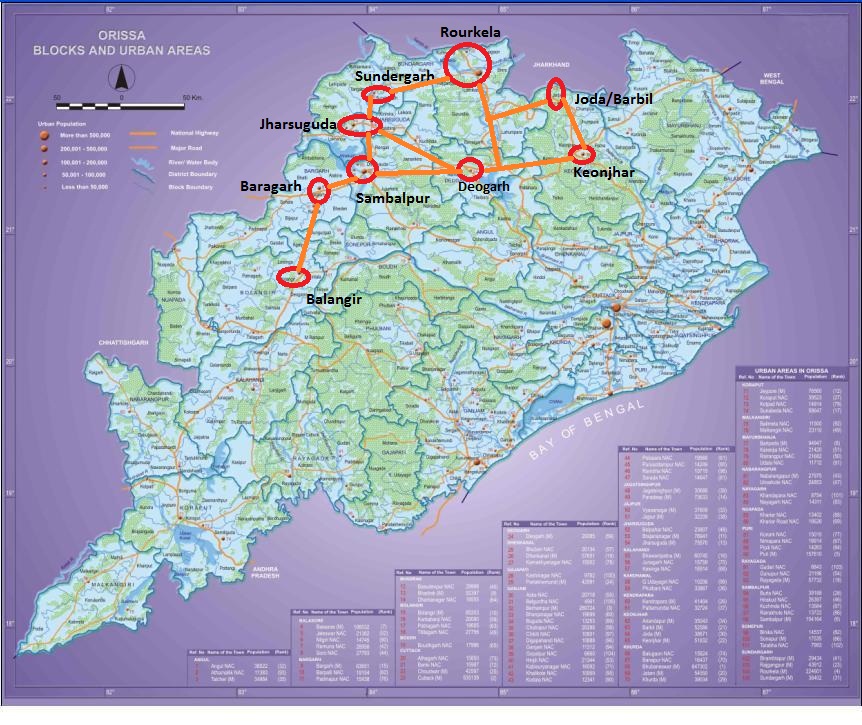Author Archive
Important Telephone Numbers of Lord Jagannath Temple & Puri: Samaja
Bhubaneswar- Cuttack- Puri, CONSUMER & RTI LINKS, Puri Comments Off on Important Telephone Numbers of Lord Jagannath Temple & Puri: Samaja
JSPL has plans for 1 lakh crore investment in Odisha including an engineering college and a power training institute
Angul, Anugul- Talcher - Saranga- Nalconagar, Business Standard, Coal, Coal to diesel, Engineering and MCA Colleges, Gasification (from Coal), Jindal, Steel Comments Off on JSPL has plans for 1 lakh crore investment in Odisha including an engineering college and a power training instituteFollowing is an excerpt from a report in Business Standard.
… "After completing the official procedures, we will sign an MoU for the CTL project involving an investment of Rs 42,000 crore," JSPL Executive Vice-Chairman and Managing Director Naveen Jindal told reporters after a meeting with Chief Minister Naveen Patnaik here this evening.
…Stating that he discussed with the chief minister the group’s four projects comprising the Rs 52,000-crore steel plant, a thermal power plant involving Rs 6,600 crore, the Rs 42,000-crore CTL plant and an industrial complex envisaging an investment of Rs 500 crore, Jindal said a total of Rs 1,01,100 crore would be invested in Orissa over the next decade.
"We also discussed (with the chief minister) on our proposal of enhancing steel capacity from 6 million tonne per annum (mtpa) to 12.5 mtpa," he said, adding the department of steel and mines is likely to list this project for consideration of the task-force by the end of July.
Jindal said, on completion, "about 80,000 barrel of oil per day will be manufactured from the proposed CTL plant." The project is likely to be listed in next task-force meeting in July itself, he added.
… Earlier, the Tata Group, in collaboration with Sasol of South Africa, had evinced interest in setting up a similar coal-to-liquid plant in the state.
… Jindal indicated to set up the unit in Angul district where its steel plant is being built.
JSPL, which had already been alloted a coal block in the state, would complete its proposed CTL petroleum project in eight years, a company executive said, adding about 32,000 would get employment in the project.
… While many mega industries face difficulties in implementing their MoUs, the JSPL chief said his company got support of the local people in Angul district.
Besides these four mega projects, JSPL is also working on setting up an engineering college and a power training institute, Jindal said adding the company is committed to recruit local youths in its plants.
Solution directions to the Maoist problem – Development lessons learned from J&K and Northeast should be used
12th plan (2012-2017), Deogarh, Gajapati, KBK Plus district cluster, Malkangiri, Planning Commission and Odisha, Rayagada, Sambalpur 3 Comments »Update: The Odisha CM is making the case that five more districts be included in the list of naxal-hit districts that should be targeted for infrastructure development schemes. Those are: Koraput, Mayurbhanj, Sundergarh, Keonjhar and Kandhamal.
Following is the content of an email that summarizes a point that I have tried to make over the last couple of years. It seems the planning commission has started thinking along the same lines.
The nations attention at this time seems to be focused on the Maoist issue. While the law and order steps are probably necessary, this is a good time to recall the lessons that India learned (and that seems to have worked) in J& K and North East.
What is that lesson?
The lesson is regarding what worked in the North East and J & K is not just policing but the investment of vast amount of funds towards development programs there.
A similar approach at the same level of funding needs to be taken for the areas that are affected by the Maoist problem.
What is the level of funding for North east and J & K?
Following is extracted from the attached document from the Ministry of Home GOI.
(I can not locate it in their web page now, but I have uploaded the copy I had downloaded from their site to the site http://www.orissalinks.com/
- PM’s reconstruction plan for J&K announced in Nov 2004 is for Rs. 24,000 crores.
- 1,83,018 crores is allocated for economic development in the North east.
In contrast, for the Maoist affected areas in the states of Andhra Pradesh, Bihar, Chhatisgarh, Jharkhand, Maharashtra, Orissa and West Bengal; only Rs. 3007.50 crores were spend via Backward Districts Initiative and Rs. 1930.52 crores via Backwards Region Grant Fund.
What is the impact?
J & K and North east vs Maoist affected areas in terms of violence:
- Militancy in J & K resulted in the killing of 1,883 civilians and 789 security forces personnel.
- The militancy-related fatalities in the north-east were 1,909 civilians and 361 security forces personnel."
In contrast 2,281 civilians and 821 security forces personnel were killed between 2004 and 2008 (up to August 31) due to Maoist activity.
Thus there were more civilians and security forces killed between 2004-2008 due to Maoist activity than each in J& K and North east.
I think India needs to pay as much attention (in terms of money and development programs) to the Maoist affected areas as it is paying to J&K and North East.
Moreover, the Maoist affected areas are much poorer, much less literate, and overall more backward in all parameters than J&K and the Northeast. While J&K and Northeast are in the physical frontier of India, the Maoist affected areas are the third frontier. One must note that many countries have had more lives lost in fighting or other uphevels in their interior than in fighting an extrenal enemy. Following are some examples:
- In US, 625 thousand people died during the civil war which is more than the number that died in World war 1 and 2 put together. (see http://en.wikipedia.org/wiki/
United_States_casualties_of_ war ) - In Russia/Soviet Union, the number of deaths estimated are as high as 20 million deaths during Stalin’s regime, 9 million during civil war 1917-1922, and 10 million during the second world war. (See http://users.erols.com/
mwhite28/warstat1.htm ) - In China, the number of deaths is estomated at 2.5 million during their civil war (1945-1949), 40 million during Mao’s regime, and 10.45 million in the Second world war. (See http://users.erols.com/
mwhite28/warstat1.htm )
Thus, just because the Maoist affected areas are in the interior, they should not get less development related attention than J&K and Northeast. As the above numbers show, trouble in the interior can be actually worse than trouble in the physical frontier.
In other words, it would be prudent for GOI to take the Maoist affected areas of India as seriously as J&K and Northeast, and perhaps even more seriously, as they are more backward than J&K and Northeast and put as much or more development resources in those areas.
Currently train lines, roads, airports (in general connectivity) to J&K and Northeast are being fast-tracked and sometimes labeled as National projects. A similar approach to connectivity (rail, roads, etc.) and other development in the Maoist affected areas of India (that includes KBK, Kandhamala, Sudnergarh, Mayurbhanj etc. of Orissa) must be taken urgently.
Dear Sirs: I would like you to use the above numbers, recall the lessons learned from J & K and North East and take a balanced approach to the maoist problem; Law and order aspects combined with development programs at the same scale as in J & K and Northeast.
There is now an indication that the planning commission has started thinking along the same lines.Following is an excerpt from a report in Indian Express.
The Plan panel would be ready with the final draft of the Integrated Action Plan (IAP) for development
of the 35 naxal-hit districts spread over nine states in a month’s time.
“The Commission should be ready with the final draft of IAP in a month as consultations with organisations like civil societies are still on,” Member Planning Commission Mihir Shah told reporters after a meeting on IAP with non-government organisation here.
… Shah said funding under the IAP would be done for three years. There are suggestions from civil societies that in the naxal hit districts, Panchayti Raj institutions like Gram Sabha and Panchayat should be used for inclusive development.
… Last week, Ahluwalia had indicated that the panel is working on Rs 13,742 crore financial package for these 35 districts.
He had also disclosed that the proposal came from the Cabinet Committee on Security and would be for a three-year period for infrastructure development.
… The commission is also looking at the possibility of implementing the PESA (Panchayats Extension to Schedule Areas) Act, 1996, to give tribals the right to use minor forest produce.
Parts of as many as nine states — Andhra Pradesh, Bihar, Chhattisgarh, Jharkhand, Madhya Pradesh, Maharashtra, Orissa, Uttar Pradesh and West Bengal
— are in the grip of Naxalism.
Among these 35 districts five are in Odisha. They are: Malkangiri, Rayagada, Gajapati, Sambalpur and Deogarh. The Orissa government is pushing to include Koraput in that list.
Although this is a good start, I think much more needs to be done and to the larger area that I refer to as the third frontier. Perhaps a larger plan can be made for the 12th plan starting 2012. The approach to the 12th five year plan could be a good starting point to submit our feedback. I think the package of Rs 13,742 crores for 35 districts is a good start but not enough. The amount has to be much higher and the number of districts need to be more. In Odisha (see forest map) Kandhamala (51.51% ST), Mayurbhanj (57.87 ST), and Nabarangpur (55.27% ST) (Keonjhar and Sundergarh also have high ST percent, but they are being developed for other reasons anyway) need to be included and the infrastructure to be fast-tracked must also include Railway lines such as Khurda-Balangir line and the Chakulia-Buaramara line.
Balancing industrialization related land acquisition with people’s livelihood and their rights
Jagatsinghpur, Jajpur, Jajpur Rd- Vyasanagar- Duburi- Kalinganagar, Land acquisition, Mettalurgical Cluster - Jajpur (Kalinganagar), Paradip - Jatadhari - Kujanga, POSCO, Steel, Tatas 3 Comments »Following is an excerpt from a report in LA Times about the Nano plant in Gujarat and how some of the landlosers have managed their finances.
But Pathan, and scores like him who live in the shadow of a new factory built by Tata Motors to make its ultra-cheap Nano car, are the beneficiaries of the race to transform India from a nation of small farmers to an industrialized power.
… Against this backdrop of strife, Pathan’s story is the ideal of what could be achieved if the more than 50 percent of Indians who live off the land get a real stake in the new economy. It’s a principle that advocates of market capitalism and human rights activists can agree on, but that often fails to materialize across rural India, where stories of powerful business interests and corrupt officials conspiring to throw poor farmers off their land are all too common.
Around the Tata plant in Sanand, in the western state of Gujarat, people have begun to talk of the "Nano effect."
Go down a narrow lane that runs to dirt not 15 minutes from the factory and amid the gamboling goats of Chharodi village, you will find 25 new homes.
Property prices have risen sharply — from 50 to 400 percent — and men are making fortunes brokering land deals.
The village head says three dozen of the 3,000 people in Chharodi have gotten work from contractors. The Nano factory hasn’t given them jobs directly, but it has offered a toehold in the industrial economy. They remain farmers, but a growing part of their income comes from informal business ventures or work for contractors.
Pathan and his three brothers sold the government one-third of their family farm to make way for the Nano plant. They were paid 20 million rupees ($432,900) — a fortune even in Gujarat, one of India’s richest states.
Ask the Pathan brothers what they did with this money, and they grin like schoolboys.
They bought 2.7 hectares (6.6 acres) of land — more than doubling their initial landholding — three kilometers (two miles) away, where they are preparing to plant their first crop.
They bought seven tractors and three Bolero jeeps, which they use for contracting work at the Nano site, raking in 455,000 rupees ($9,848) a month.
They are rebuilding their family home. Gone is the mud and thatch. Today their angular concrete two-story is the biggest on the block.
"You’ve done a damn good job out here," Pathan says of Ratan Tata, who heads the Tata group’s sprawling industrial empire.
The underlined part above is an important part. If the land losers are paid multiple times the "current" value of their land, in most places they can easily buy more than that amount of land within a few kms.
Following is an excerpt from a Nageswar Patnaik article in Economic Times.
There is something to cheer about for the families displaced by the Tata Steel Project at Kalinganagar. These families have achieved zero dropout rate at elementary school level, sustainable environment, poverty eradication, increase in literacy rate, gender equality, empowerment of women.
The achievers of these challenging Millennium Development Goals (MDGs) are not highly educated and extraordinary urbanite people, but ordinary members of self-help groups residing in rehabilitation colonies at Kalinga Nagar in Orissa’s Jajpur district.
Helped by country’s major steel producer, Tata Steel, the self-help groups called Tata Steel Parivars (TSPs) have successfully ensured that all children living in the colony went to the school and got education. Tata Steel is setting up of a 6-million ton per annum integrated steel plant at Kalinganagar Industrial Complex at Kalinga Nagar in Jajpur district.
“The noteworthy achievement of Tata Steel Parivars [TSP] at Kalinganagar is that those families have achieved the target of 100% elementary education with zero school drop out rate,” says Sukanta Rout, an educationist who played a crucial role in motivating the children, mostly tribals, to go to the school.
As many as 159 tribal children have been enrolled in the residential schools in Jajpur district. Similarly, 50 children have got the opportunity of studying in one of the premier schools of the state – Kalinga Institute of Social Science (KISS), here. As many as 213 children are studying in schools as day scholars.
Simultaneously, there is significant jump in the literacy levels of the TSPs from 45% in 2005 to 65% in 2010.
Most significantly, there has been an incredible and drastic change in the will power of women of these relocated families. The empowered women community are now self-employed and going overboard for what they are doing. They have engaged themselves in poultry farming, gardening, stone carving, saura painting and in setting up of small industries like phenyl and pickles.
“A few years before, we were quite poor, – we did not have money to even buy food, let alone send our children to school. Now with own our income, we are not only meeting our day-today expenses but also support our school and college-going children,” says Jamiti Mahanta, head of an SHG group.
If the industries that are coming up in Odisha, such as POSCO and Vedanta, can be made to do the above and perhaps more then it will be a win-win situation for all. POSCO’s current package seems to be a step in the right direction. Following is an excerpt from a Business Standard article on that.
Posco, the biggest foreign direct investment (FDI) in India at $12 billion (Rs 54,000 crore), has offered the largest ever compensation package in the country for the displaced and landless farmers.
The Rs 400 crore compensation — part of its estimated project cost — announced by Posco India for Orissa, is expected to benchmark industry relief in the country. The package will benefit over 2000 encroachers and landless labourers at the Posco site.
While Rs 100 crore will be provided for the acquisition of government and private land, Rs 100 crore will be given towards building a rehabilitation colony and Rs 200 crore as compensation to encroachers of government land.
The move – including encroachers of government land and landless labourers earning their livelihood from the area – was beyond the prescription of the state or national rehabilitation and resettlement (R&R) policies.
While fixing the price of private land at Rs 17 lakh per acre, the Rehabilitation and Periphery Development Advisory Committee (RPDAC) for the Posco project announced a compensation of Rs 11.5 lakh an acre for the loss of betel vines, most of which are on government land. There are about 1,877 betel vines in the site covering 300 acres.
Landless labourers working in the betel vines will get 20 per cent of the total compensation for the loss, which is over and above the amount paid to the owners of the areas where betel is grown.
Similarly, RPDAC has prescribed assistance of Rs 2 lakh per acre for owners of the prawn gheris — most of which are operating on government land — and Rs 1 lakh an acre for farmers using government land for agriculture.
In a never-before step, the South Korean steel giant’s package will pay an unemployment allowance of Rs 2,250 a month to the landless labourers, who will lose their livelihood following the acquisition, till they are provided job by the company. Capping it all, RPDAC has decided to provide alternative housing to families who had encroached and built their houses on government land.
In comparison, the compensation package for sharecroppers or landless labourers in Bengal’s Singur was 25 per cent of what the land owner received — for a single-crop Rs 2 lakh and Rs 3 lakh for double-crop farmland. In Nayachar, the West Bengal government had promised to rehabilitate 100-150 fishermen families who had encroached upon government land — the site for a chemical hub.
The rate is also more than what neighbouring Chhattisgarh is offering. The government there recently hiked the compensation to Rs 10 lakh for an acre for two-crop farmland, Rs 8 lakh an acre for single-crop un-irrigated land and Rs 6 lakh for barren land.
The captive mines given to these companies and the royalty rate is a different issue. I believe that currently the royalty given to the state is too little.
Gokul Agrawal of CTC Education Pvt Ltd intends to invest Rs 6000 crore over five years in developing a 1000-acre knowledge city
Bhubaneswar- Cuttack- Puri, Ganjam, Hotels and resorts, Jagatsinghpur, Jharsugurha, Jharsugurha- Brajarajnagar- Belpahar, Khordha, Paradip - Jatadhari - Kujanga, Sambalpur-Burla-Jharsuguda 1 Comment »Following is an excerpt from a report in Business Standard.
Topping the lists of the prospective investors is Gokul Agrawal of CTC Education Pvt Ltd who intends to invest Rs 6000 crore over five years in developing a 1000-acre knowledge city.
In the higher education sector, Silicon University of the Silicon Valley Group has proposed to set up its campus in the state at a cost of Rs 300 crore. Investments would also be pouring in for the state’s hospitality sector with the US-based Best Western Hotel lining up a Rs 100-crore investment plan for setting up a chain of properties at Bhubaneswar, Paradip, Chilka and Jharsuguda.
Land could become an issue with respect to the proposed knowledge city. A city/town/community that may want such a knowledge city which, I am told, would include multiple universities could offer help in the land part. They should of course first investigate if the group really has that much money and if their plan is for real.
Line drawing of the Puri Rath Yatra in 1818 conserved at the British Library: Dharitri
Lord Jagannath, Odisha history, Puri, Ratha yatra Comments Off on Line drawing of the Puri Rath Yatra in 1818 conserved at the British Library: DharitriLivemint writes about Balangir MP Kalikesh Singh Deo in its article on legislative assistants
Balangir, Odisha personalities 1 Comment »See http://www.livemint.com/mp-assistants.htm for a video interview with Mr. Singh Deo. The following article is by Pallavi Singh.
Status update on water transport and waterways in Odisha: Dharitri
Balasore, Kendrapada, Puri, State river routes Comments Off on Status update on water transport and waterways in Odisha: Dharitri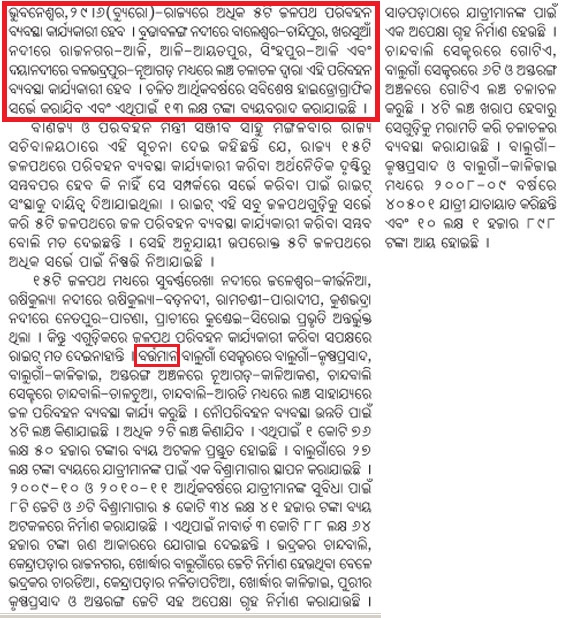
Following is from a front page opinion story in The Telegraph.
ORISSA DAILYOrissa is an ancient seat of culture and The Telegraph is the newest chronicler and analyst of the state’s many achievements and of the activities of its people. This contrast between the ancient and the latest should not, however, be pushed too far because Orissa is today a vibrant province and The Telegraph is wise beyond its years. The contrast carries within it the promise of a fruitful partnership. In the last decade or so, Orissa has rapidly transformed itself from a backward and poor state into one that is seen by most investors, domestic and foreign, as the preferred destination. The chief minister of the state, Naveen Patnaik, has claimed that Orissa has attracted investments of Rs 6 lakh crore. Given the fact that Orissa is rich in mineral resources, it is not surprising that mineral-based resources have attracted the bulk of the investments. But infrastructure, especially power, transport and communication, has also seen substantial inputs of capital and an impressive record of growth. All these suggest that Orissa is poised to be the pace setter of economic development in eastern India, if not in India. The Telegraph comes to Orissa with the eagerness to report and analyse the events of this phenomenal success as it unfolds day to day.
It would be simplistic to view the Orissa success story only through the prism of economic achievements. Education, the most important vehicle to make any growth sustainable, has also felt the winds of change. The fruits are most visible in the field of higher education with the establishment of an Indian Institute of Technology in Bhubaneswar and the National Institute of Science, Education and Research, and many other government and private institutes. With a thriving poverty alleviation programme — according to a World Bank study, Orissa has lifted nearly three million people out of the vicious circle of poverty and debt — it can be expected that primary education will also experience a spurt in growth. The people of Orissa and the political class that represents them are displaying the political will to free the state from the coils of past backwardness. This will is also manifest in the manner in which the people of Orissa attempt to refashion their own proud regional identity with a new and emerging presence in the national scene. This is one reason why Orissa is an exciting place. The Telegraph, by bringing that excitement to its readers, wants to be part of it.
Bollywood playback singer Krishna Beura; well known for singing “sufi” songs
Odisha personalities 4 Comments »Following is from Samaja.
Some of his famous songs are:
"Maula Mere" from the film Chak De India He won the Stardust 2008 Award for New Musical sensation(male) for this song.
"Soniyo from the Heart" (Raaz-2)
Deewaar (song: "Ali Ali")
His wikipedia page is http://en.wikipedia.org/wiki/Krishna_Beura.
Odisha Climate Change Action Plan: Draft available to receive more inputs
ENVIRONMENT, Odisha govt. action 2 Comments »Following is an excerpt from a blog entry in the world bank site.
Lashed by heavy monsoon rains and devastating cyclones with unfailing regularity, the state looked for solutions. In doing so, it also stole a march on the central government, whose National Climate Change Action Plan is still being prepared in fits and starts.
… So, to chart the way forward on development in an era of climate change, the government decided to consult with diverse groups —a participatory approach endorsed by the Bank. The commitment came from the highest levels in the state government. The Bank helped by providing global knowledge and expertise, and mobilizing both national and international experts, as and when needed.
Consultations sought solutions for the coastal areas, tribal regions, mining and industrial areas, urban centers and farming belts. Fishermen, farmers, trade unions, industrial associations, tribal groups and women offered their comments. Not surprisingly, the discussions were often animated and intense.
A diverse set of questions was raised: What should be done to control the growing salination of the coastal belt that is ruining farmer livelihoods? How can we preserve the natural breeding grounds for fresh water fish? And what can be done for the fishermen who, with falling fish stocks, are abandoning their age-old profession and migrating to cities in search of work? Then, what’s the best way to stop fluoride and arsenic from leeching into the drinking water? And, if you’re wondering what happened between the forest officers and the mining ones, let’s just say that the forest officers finally succeeded in extracting a commitment from the mining officials to adhere to sustainable practices and greater environmental monitoring.
The draft plan is now up on the Orissa government’s website to receive more inputs. While the plan may not be perfect, it is innovative and home grown, and open to improvement. And all said and done, by being the first past the post, the little state of Orissa has shown the richer states the way!
Data Centers to provide BC (Business Continuity) and DR (Disaster Recovery) to come up in Delhi, Pune, Hyderabad and Bhubaneswar
Bhubaneswar- Cuttack- Puri, Central govt. schemes, E-governance, IT Comments Off on Data Centers to provide BC (Business Continuity) and DR (Disaster Recovery) to come up in Delhi, Pune, Hyderabad and BhubaneswarFollowing is an excerpt from a report in expresscomputerline.
S.P. Singh, Sr. Director, DIT, Government of India, underscored the importance of support infrastructure in e-governance implementations. The government of India has taken the initiative of providing this infrastructure and its three pillars are State WAN (SWAN), State Data Centers (SDC) and Citizen Service Centers (CSC).
…The mandate of the SDC scheme is that data centers are to be set up in all 35 states and union territories. It involves an outlay of 1,623 crores over five years and this takes care of the CAPEX for setting up data centers as well as the OPEX for five years.
The idea (SDC) is to concentrate and migrate IT infrastructure in state governments to a centralized environment that provides 24×7 services.
With regard to BC and DR, Singh said the four data centers of the NIC will provide disaster recovery to individual states. A 64,000 sq. ft. data center will come up in Delhi to begin with. Pune, Hyderabad and Bhubaneswar will follow suit eventually.
BC refers to Business Continuity and DR refers to Disaster Recovery.
Vedanta making a multi-speciality hospital in Jharsuguda; Apollo and Fortis may jointly run it
Aluminium, Anil Agarwal, HEALTHCARE and HOSPITALS, Jharsugurha, Vedanta 9 Comments »Following is an excerpt from a report in Business Standard.
After the successful operationalization of its smelter plant at Jharsuguda, Vedanta Aluminium Limited (VAL) has now decided to set up a state-of-the-art, multi-speciality hospital at the same location at an investment of Rs 50 crore.
… The hospital will be spread over nine thousand sq metres.
Construction work on the hospital has kicked off in June 2010 and it is scheduled to be fully operational by January 2011. Mumbai-based Hosmac India Limited, a noted company in the field of hospital planning and management consultancy, has been roped in for the design and lay-out of VAL’s hospital.
The overall layout of the hospital is designed keeping in view the comfort and convenience of the patients and their attendants. Despite being a high-class hospital in terms of its structure and services, it will serve the people belonging to different socio-economic groups and especially and will be dedicated to timely and affordable medical assistance to the poor.
To ensure a highly professional approach in the running of the hospital, VAL is negotiating with healthcare majors like Apollo Group of Hospitals and Fortis. Both these hospitals are expected to operate the hospital jointly. …
Nine industrial proposals get single window clearance: Samaja
Aluminium, Anil Agarwal, Berhampur- Gopalpur- Chhatrapur, Dhenkanal, Ferro-chrome, Ganjam, Industrial Parks, Jagatsinghpur, Jajpur, Jajpur Rd- Vyasanagar- Duburi- Kalinganagar, Jharsugurha, Kalahandi, Kendrapada, MSE - medium and small enterprises, Paradip - Jatadhari - Kujanga, Rayagada, Rayagada- Therubali, Samaja (in Odia), Single Window Clearance (SLSWCA), Sonepur, Steel ancilaries, Sugar, Thermal Comments Off on Nine industrial proposals get single window clearance: Samaja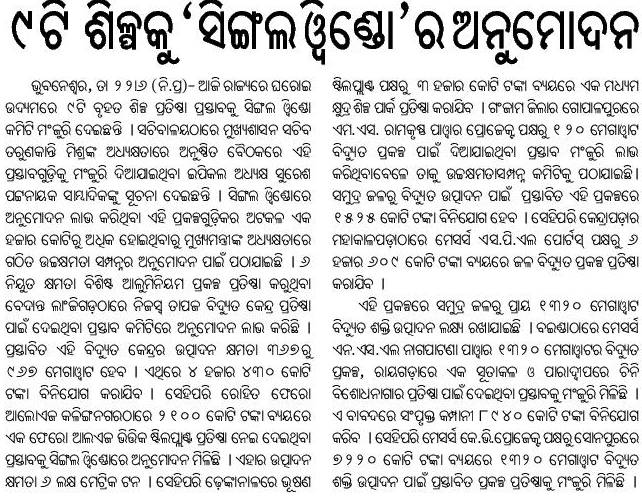
Kendrapada pursues industry and may taste its first success
Kendrapada, Single Window Clearance (SLSWCA), Thermal 1 Comment »Following is an excerpt from a report in tathya.in.
Jay Panda is very happy today.
Member of Parliament from Kendrapara is in high spirits because finally the NO-Industry District, Kendrapara will have a major power plant.
Thanks to the initiative of SPI Ports Private Limited (SPIPPL), a Tamil Nadu based conglomerate.
The State Level Single Window Clearance Authority (SLSWCA) has cleared the 1320 megawatt (MW) coal based thermal power plant at village Alailo in Mahakalpada tahsil.
… The Tamil Nadu based company is part of SPI Group involved in Steel, Power Generation, Infrastructure Development, Entertainment, Distilleries and associates are involved in food processing.
A patch of land of 1185 acres of non-irrigated land has been identified for the purpose, which is free from habitat and away from Command Area.
However requirement of land is only 750 acres and 60 cusecs of water is available from adjacent Gobari Canal.
Annual coal requirement for the project is 4.17 million ton for 1320 MW.
An annual contribution of 6 paise per unit of the energy sent out from the plant, but not sold in the state to be made by the developer towards Environmental Management Fund.
… Company has shown interest in setting up agro based industry in the area.
The article is correct. MP Jay Panda has been trying his best to locate industries in Kendrapada. We congratulate him on his success.
State Single Window Clearance Authority approves expansion of Vedanta plants in Lanjigarh and Jharsuguda
Aluminium, Anil Agarwal, Bauxite, Jharsugurha, Jharsugurha- Brajarajnagar- Belpahar, Kalahandi, Single Window Clearance (SLSWCA), Thermal, Vedanta Comments Off on State Single Window Clearance Authority approves expansion of Vedanta plants in Lanjigarh and JharsugudaFollowing is an excerpt from a report in tathya.in.
The State Level Single Window Authority (SLSWA) chaired by the Chief Secretary green signalled projects worth of Rs.37,440 crore.
Expansion of Alumina Refinery at Lanjigarh in Kalahandi from the existing 1 Million Ton Per Annum (MTPA) to 6 MTPA has been allowed.
This project is facing opposition from local people and Union Minister for Forest & Environment, said sources.
Aluminium Smelter at Jharsuguda from the existing 0.25 MTPA to 1.60 MTPA expansion allowed by the Authority, said an official.
Similarly expansion of the Captive Power Plant (CPP) at Jharsuguda from 675 MW to 1350 MW has been allowed, said sources.
These proposals were pending earlier and with the clearance of Single Window Authority, it will go to the High Level Clearance Authority (HLCA) for final clearance, said an official.
Development locations in the three regions of Odisha – in maps
Anugul- Talcher - Saranga- Nalconagar, Balasore- Chandipur, Baripada- Bangiriposi- Similipal foothills, Berhampur- Gopalpur- Chhatrapur, Bhubaneswar and vicinity, Bhubaneswar- Cuttack- Puri, Dhamara- Chandbali- Bhitarakanika, Jajpur Rd- Vyasanagar- Duburi- Kalinganagar, Jharsugurha- Brajarajnagar- Belpahar, Koraput- Jeypore- Sunabedha- Damanjodi, Overall Odisha, Paradip - Jatadhari - Kujanga, Rayagada- Therubali, Rourkela- Kansbahal, Sambaplur- Burla- Bargarh- Chipilima 1 Comment »The Central & Southwestern Outposts of Odisha
Balangir, Gajapati, Kalahandi, Kandhamala, KBK Plus district cluster, Koraput, Koraput- Jeypore- Sunabedha- Damanjodi, Malkangiri, Nabarangpur, Nuapada, Rayagada, Rayagada- Therubali 1 Comment »Earlier we discussed the coastal belt and the western industrial corridor. However, there is a big part of Odisha outside of these two areas. Although, that area was long neglected except small industrial pockets in Rayagada and Koraput area, things have started happening in the overall area. Following is a map of that.
.jpg)
In the map above Berhampur and Balangir are reference points for the southern tip of the coastal belt and western industrial area respectively. Coming back to the outposts the current industrial areas are:
- Koraput-Jeypore Sunabeda and
- Rayagada-Therubali
They are 150 kms apart. Besides industries, both areas have several engineering colleges and a central university (possibly with a medical college) is coming up near Koraput.
North of Rayagada-Therubali is the Lanjigarh operations of Vedanta and its emerging township. How fast this area develops will depend on how quick there is an understanding between the loacls and the Vedanta people.
Further north is the Bhawanipatna-Kesinga-Titlagarh area. Titlagarh is a railway junction. A train line connecting Bhawanipatna and Junagarh to Lanjigarh rd of the Raygada-Titlagarh line should have passenger traffic in a couple of years. Recently, Bhawaniptna is getting some attention from the state government in terms of HRD institutions. A government engineering college and a government agricultural college has started here and the higher education task force has recommended a state university here. A private medical college is under construction. (However, its progress is slow.) I hope the government takes over the medical college infrastructure that has been built and makes it a government medical college and a location in this area is chosen for the announced Railway wagon factory. However, for the area to further develop and develop rapidly, the locals need to actively chip in. They need to learn how locals in the Koraput area, Rayagada area, Gunupur and Parlakhemundi have created and/or facilitated private HRD infrastructure. (For example, each of them have private engineering colleges.) In addition they should form a win-win partnership with Vedanta. If people don’t help themselves and don’t stop actively opposing private development instead of facilitating it, there is only so much the governments can do.
On the eastern side Parlakhemundi and Gunupur are slowly emerging as educational mini-hubs. The JITM and CRESM in Parlakhemundi are together becoming a private university and Gunupur has the biggest (in terms of student intake) engineering college (private or government) of the state. The railway line connecting Gunupur and Parlakhemundi to the Howrah-Chennai line at Naupada is about to start passenger service.
The lone central outpust is Phulbani. At present it has nothing much except some negative name recognition. The government needs to pay attention to this starting with pushing for the early establishment of a branch of the Tribal University here.
However, there are still several areas which are being left out. This includes the area south of Koraput (namely the Malkangiri district) and the districts of Nabarangpur and Nuapada. Unless development spreads there, they will be the new KBK of Odisha.
The Rourkela-Jharsuguda-Sambalpur industrial corridor of Odisha
Balangir, Bargarh, Jharsugurha, Rourkela-Jharsuguda, Sambalpur, Sundergarh 1 Comment »Currently the HRD infrastructure in the western corridor are concentrated at two locations (i) Rourkela and (ii) Sambalpur. While Rourkela has a lot of industries, the new ones are more concentrated around Jharsuguda.
In terms of connectivity the second airport of the state is being made at Jharsuguda and Jharsuguda has the best rail connectivity as it is a junction in the Howrah-Mumbai route as well as connected to Balangir via Sambalpur and Bhubaneswar via Sambalpur. Jharsuguda and Sambalpur, 40 kms apart, if taken together have superb rail connectivity to the rest of the country.
Very soon the western corridor will be connected to the eastern corridor by multiple railway lines:
- Sambalpur-Angul-Bhubaneswar (exists)
- Barbil-Keonjhar-Kalinganagr (exists; a more direct connection between Barbil and Keonjhar is being made)
- Balangir-Bouda-Khurda Rd (under works)
- Rourkela- Bimlagarh-Talcher (Bimlagarh-Talcher is under works)
This area has some knowledge infrastructure centered around Sambalpur-Burla and Rourkela:
- There are two universities in Burla (VSSUT and Sambalpur Univ) with two more in the pipeline (Upgradation of GM College and upgradation of VSS Medical College).
- There is a medical college in Burla.
- Rourkela has NIT and BPUT and a metropolitan university is planned.
- HiTech is making a private medical college in Rourkela. (SAIL should be pushed to make a medical college there; ESIC should also establish its medical college somewhere nearby.)
To bring this whole corridor together some focus needs to be directed towards Jharsuguda. The airport coming there; it being the main Railway junction; and Vedanta’s plants there are additional reason to put some focus on Jharsuguda. I suggest:
- A university be made there with partnership between the government and the industries there.
- The Jharsuguda engineering school be made to an engineering college.
- A medical college be made there (or in between Jharsuguda and Sundergarh) by the companies that mine from the Rampia block. (They should learn from MCL which is making its medical college in Talcher. MCL HQ is in Sambalpur, but I guess its coal mines are in Angul and hence the medical college in Talcher.)
- The proposed power management institute of Odisha be established there.
The two other ends, Balangir and Joda-Barbil/Keonjhar need also some care.
- A university has been proposed for Balangir and XIM is interested in opening a branch there. More needs to happen there.
- Joda-Barbil is grossly neglected. A more direct rail connection between Joda-Barbil and Rourkela needs to be made. In addition HRD institutions need to be established in Joda-Barbil as well as Keonjhar.
One needs to note that NH-6, which at some point will become part of an expressway from Kolkata to Mumbai connects Keonjhar to Sambalpur and Bargarh. Thus one can envision a semi-ellipse with Baragarh-Sambalpur-Keonjhar line making the bottom part while the Sambalpur-Jharsuguda-Sundergarh-Rourkela-Barbil/Joda-Keonjhar making the upper curve. At some point Deogarh (next to the Rengali reservoir) the midpoint of Sambalpur and Keonjhar on NH-6 needs to be further developed.
Approach for the 12th five year plan: Safeguarding Odisha’s interest
12th plan (2012-2017), Planning Commission and Odisha Comments Off on Approach for the 12th five year plan: Safeguarding Odisha’s interestThe current five year plan is from 2007-2012. The next five year plan (12th plan) will be from 2012-2017. From now until until 2013 various details of the 12th plan will be put in place. we need to watch out the discussions and news reports on this and make sure that Odisha gets its due share. Following are excerpts from an Hindu news report on an initial meeting about the 12th plan.
The Planning Commission, Deputy Chairman, Mr Montek Singh Ahluwalia, on Saturday held a meeting with experts from various fields on the approach for the 12th five year plan.
“The meeting was for consultation with experts for the ‘Approach’ for the 12th Plan. We discussed broad issues today.
… On the issue of growth, the Deputy Chairman said, “The Prime Minister has asked us that we should aim for 10 per cent growth in the next Plan.
“Everybody feels and we also think that growth should be inclusive and sustainable. That means without environmental damage.”
The meeting was attended by the Chairman of the Unique Identification Authority of India (UIDAI), Mr Nandan Nilekani, the former Nasscom President, Mr Kiran Karnik, and the former Thermax Chairperson, Ms Anu Aga, among others, apart from officials of the Planning Commission.
We should not be only reactive, rather we should be proactive in pushing issues that will help Odisha. Following are some initial thoughts.
- Odisha should push that India’s Maoist/Tribal/forested belt that includes a large part of Odisha and adjoining states of Chhatisgarh, Jharkhand, Andhra Pradesh and West Bengal should have investment amounts and priority (with respect to infrastructure development) similar to what is accorded to the North Eastern states and J & K. This would entail expediting planned Rail connectivity in these areas;
- Work in Progress
Investment in cement sector in Odisha
Balasore, Bargarh, Cement, Jharsugurha, Malkangiri, Sundergarh Comments Off on Investment in cement sector in OdishaFollowing is excerpted from a report in Financial Express by Dilip Bisoi.
- five units entailing a total investment of Rs 4,162 crore.
- The state promises 2.224 billion tonne of limestone deposits. Moreover, Orissa is going to generate huge quantity of blast furnace slag and fly ash as a large number of steel units and coal-fired power plants are coming up in the state.
- Madras Cements, which is known for its popular Ramco brand, is proposing to set up two cement projects in the district of Sundergarh and Malkangiri of the state. While it is planning a 2 million tonne per annum (MTPA) plant along with a 40 mw captive power station at a cost of Rs 750 crore in Sundergarh, in Malkangiri it is going to set up a 2 MTPA unit along with a 35 mw power station at a cost of Rs 700 crore.
- Madras Cements is also going to invest Rs 35 crore to set up a cement fibre sheet plant in Sundergarh district.
- Shree Cement, which is known for its Bangur brand, is planning to set up a 3 MTPA unit and a 50 mw power plant at a cost of Rs 683 crore in Malkangiri district.
- ACC Cement, which acquired the Bargarh Cement Plant of the Orissa government in 2004, intends to set up a 3 MTPA cement plant and a 50 mw power plant at a cost of Rs 1,850 crore in Malkangiri.
- The Kolkata-based Emami Group is proposing to invest Rs 179 crore to set up a 0.6 MTPA cement grinding facility at Somnathpur in Balasore district. The group has a newsprint manufacturing unit at Balgopalpur in Balasore district.
- Earlier, the government signed three MoUs in the cement sector. Grasim Cement of the Birla Group signed an MoU in 2006 to set up a 0.90 MTPA cement plant in Sundergarh district at a cost of Rs 1,200 crore, while ASCO Cement is putting up a 0.50 MTPA unit at a cost of Rs 132 crore at Rajgangpur in Jharsuguda district.
- OCL India, which already has a ement unit in the state, is setting up another unit in Sundergarh district with an investment of Rs 850 crore.
- Companies like Shiva Cement, Chariot Cement, Sita Cement already have cement manufacturing facilities in the state.
